
The apple maggot, also known as the railroad worm, is a species of fruit fly, and a pest of several types of fruits, mostly apples. This species evolved about 150 years ago through a sympatric shift from the native host hawthorn to the domesticated apple species Malus domestica in the northeastern United States. This fly is believed to have been accidentally spread to the western United States from the endemic eastern United States region through contaminated apples at multiple points throughout the 20th century. The apple maggot uses Batesian mimicry as a method of defense, with coloration resembling that of the forelegs and pedipalps of a jumping spider.

The Ulidiidae or picture-winged flies are a large and diverse cosmopolitan family of flies (Diptera), and as in related families, most species are herbivorous or detritivorous. They are often known as picture-winged flies, along with members of other families in the superfamily Tephritoidea that have patterns of bands or spots on the wings. Some species share with the Tephritidae an unusual elongated posteroapical projection of the anal cell in the wing, but can be differentiated by the smoothly curving subcostal vein. Two species, Tetanops myopaeformis and Euxesta stigmatias, are agricultural pests.

The Pyrgotidae are an unusual family of flies (Diptera), one of only two families of Cyclorrhapha that lack ocelli. Most species are "picture-winged", as is typical among the Tephritoidea, but unlike other tephritoids, they are endoparasitoids; the females pursue scarab beetles in flight, laying an egg on the beetle's back under the elytra where the beetle cannot reach it. The egg hatches and the fly larva enters the body cavity of the beetle, feeding and eventually killing the host before pupating. In the United States, some species of Pyrgota and Sphecomyiella can be quite common in areas where their host beetles are abundant. Like their host beetles, these flies are primarily nocturnal, and are often attracted to artificial lights.
Aciurina is a genus of tephritid or fruit flies in the family Tephritidae.

Procecidochares is a genus of tephritid or fruit flies in the family Tephritidae.
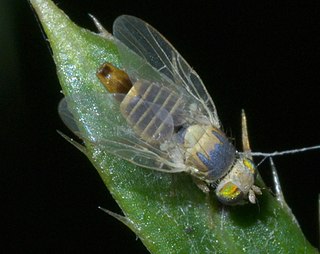
Neaspilota is a genus of fruit flies in the family Tephritidae.
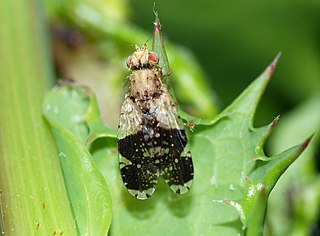
Tephritis is a genus of flies. It contains around 170 described species, making it the sixth largest genus in the family Tephritidae. Many more undescribed species are known from specimen collections. Tephritis occur throughout much of the world, but most are Palearctic. They can be found in a wide range of climate types, from hot semidesert to tundra. Most species inhabit the inflorescences of plants from several tribes in the family Asteraceae, and a few species cause galls to form.

Urophora is a genus of tephritid or fruit flies in the family Tephritidae.

Euaresta is a genus of flies in the family Tephritidae that live in plants of the closely related genera Ambrosia, Xanthium, and Dicoria, and feed on their flowers and seeds.
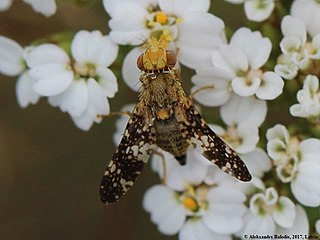
Oxyna is a genus of fruit flies in the family Tephritidae. There are at least 20 described species in Oxyna.

Trupanea is a genus of tephritid or fruit flies in the family Tephritidae.
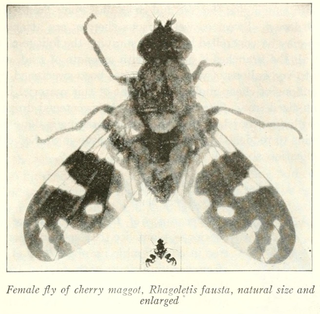
Rhagoletis fausta, the black-bodied cherry fruit fly, is a species of tephritid or fruit flies in the genus Rhagoletis of the family Tephritidae. It is found in the United States and Canada.
Rhagoletis juglandis, also known as the walnut husk fly, is a species of tephritid or fruit fly in the family Tephritidae. It is closely related to the walnut husk maggot Rhagoletis suavis. This species of fly belongs to the R. suavis group, which has a natural history consistent with allopatric speciation. The flies belonging to this group are morphologically distinguishable.
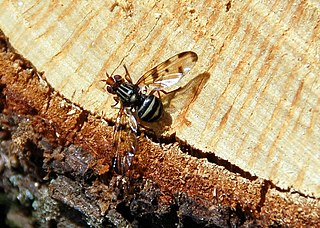
Otitinae is the name of a subfamily of flies in the family Ulidiidae. It was formerly the Otitidae. Like the Ulidiinae, most species are herbivorous or saprophagous. Most species share with the Tephritidae an unusual elongated projection of the anal cell in the wing, but can be differentiated by the smoothly curving subcostal vein. Most are dull gray to shiny brown or black flies with vein R1 setulose or, in a few cases, bare.

Euleia is a genus of tephritid or fruit flies in the family Tephritidae. Cryptaciura is considered to be a synonym of Euleia.
Epochrinopsis is a genus of the family Tephritidae, better known as fruit flies.

Tephritini is a tribe of fruit flies in the family Tephritidae. There are about 80 genera and some 1000 described species in Tephritini.
Guy L. Bush (1929–2023) was an evolutionary biologist, entomologist, and John Hannah Distinguished Professor at Michigan State University. He was also the first director of MSU's Graduate Program in Ecology, Evolution, and Behavior. Bush is best known for his research on the process of speciation, especially for his evidence of sympatric speciation in the apple maggot fruit fly, Rhagoletis pomonella, which shifted from using its native host, hawthorn tree, to using the domesticated apple tree in the last 150-200 years.
This page is based on this
Wikipedia article Text is available under the
CC BY-SA 4.0 license; additional terms may apply.
Images, videos and audio are available under their respective licenses.















